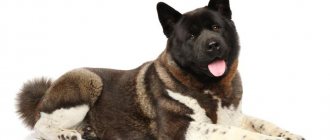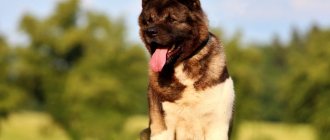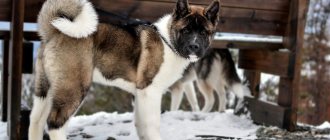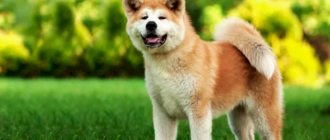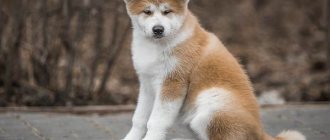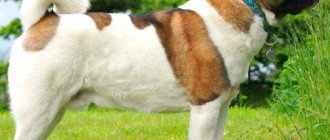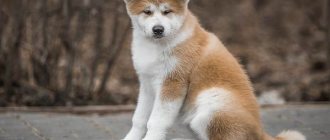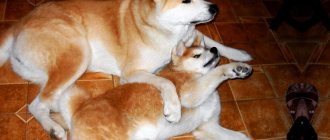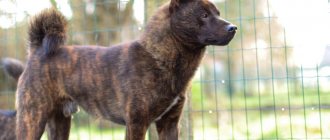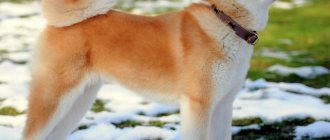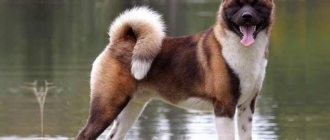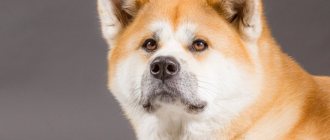Review author: “ZooVita”
Akita Inu are strong, willful and incredibly charming dogs. This breed gained particular popularity with the release of the film “Hachiko: The Most Faithful Friend,” which tells a touching story of the devotion of a dog of this breed to his owner.
Although Akita Inus seem cute and harmless in photos, in reality they have a difficult character and can sometimes behave aggressively.
Maintenance and care
The coarse coat of the American Akita does not require specific care - combing 1-2 times a week and bathing as needed, but not more than once every 3 months. Shedding is a separate “paragraph of the life” of the owner. Akitas shed their fur and undercoat very intensively; in the autumn-spring period, intensive combing is recommended 1-2 times a day. Caring for ears, eyes, claws, and teeth is necessary, but not specific.
Walking is an important aspect of keeping any dog, but when it comes to Akitas, it's important to pay attention to socializing with their dogs. Even with full socialization, the American Akita can become aggressive towards other dogs, when alone, the pet needs to be walked longer
Most dogs with a dense undercoat have problems with dog odor; the main reasons lie in poor diet or skin diseases. The American Akita's diet depends on the owner's availability of free time. With natural feeding, only high-quality products are suitable, 50% of which are meat. Many breeders prefer to feed their dogs super-premium or premium industrial products.
Breed diseases
The health of the “American” is quite good. Pets can live up to 14 years. However, this requires proper care and treatment when necessary. The American Akita can suffer diseases typical of dogs throughout its life. There are also a number of diseases to which representatives of the breed are predisposed.
- Retinal atrophy, which can lead to loss of vision (total or partial).
- Congenital eye diseases. These include: cataracts, entropion and others. They can be detected even in infancy. A dog with a similar pathology should be cared for more carefully.
- Intestinal volvulus. Akitas with a wide chest are most prone to the disease. To prevent this from happening, the owner must carefully control the eating process. Food should not be freely available to your pet. After feeding, active pastime is prohibited.
- Cushing's syndrome. The disease is a disorder of the adrenal glands. Once diagnosed, treatment with medication will be required.
- Blood composition abnormalities. Some healthy representatives of the breed have an increased content of red blood cells. In order to avoid misdiagnosis in the future, you should donate your pet’s blood in advance to identify the anomaly.
- Pemphigus foliaceus. A skin disease that affects Akitas older than eight years of age.
To prevent common diseases, the dog is regularly shown to the veterinarian. Annual vaccination is also required.
Nutrition
You can feed the American Akita both dry food and natural products. In the case of the first feeding method, it is necessary to provide the dog with constant access to water. Food must be premium and super-premium.
They are selected according to the size and age of the pet. It is advisable to consult a veterinarian on this issue.
Attention! High-quality food contains all the necessary vitamins, so there is no need to give your pet additional minerals.
With natural feeding, the pet’s diet includes:
- meat (chicken, turkey, beef, horse meat, veal);
- cereals (buckwheat, rice);
- vegetables;
- fruits (apples, pears, bananas, berries);
- skim cheese;
- fermented milk products (kefir, yogurt, yogurt).
Babies are fed 4-5 times a day. By the age of six months they are transferred to three meals a day. From 9 months, the American Akita should eat 2 times a day.
Feeding the dog is prohibited. If there is food left in your pet's bowl after eating, you should reduce the serving size.
An adult American Akita should receive about 700 grams of meat, 350 grams of porridge and 300-500 grams of fruits, vegetables and dairy products per day. As natural supplements, you can give your pet 1-2 times a week:
- chicken or quail eggs;
- seaweed;
- lean sea fish.
Vitamins and minerals in tablets can be added to food after consultation with a veterinarian.
History of the breed
The blood of the American Akita contains the blood of two very, very serious ancestors:
- Japanese Akita;
- English Molosser dogs.
While Japanese dogs have retained the purity of the breed to this day and are well known throughout the world, Molossians in their original form have long since disappeared. In fact, the descendants of these animals are not only the American Akita, but also:
- Great Danes;
- mastiffs;
- Anatolian Karabashi;
- Pyrenean mountain dogs;
- boxers, etc.
Information about Molossian dogs was discovered by archaeologists and scientists after excavations were carried out, during which images of these animals were discovered. By the way, the estimated time of writing these images is a period that ended before the advent of our era.
The Molosser is an extinct breed, but its blood runs through many other dog breeds today.
The approximate date for the start of breeding work on the American Akita is considered to be the 1860s. The fact is that in 1854, Japanese shipping ports opened to the whole world, after which residents of foreign countries began to come to the country en masse, who noticed the unusually beautiful aboriginal dogs. Of course, some animals were exported to other countries, in particular to the United States of America, where work began on breeding the American Akita.
Of course, such an animal could not help but attract the attention of local breeders. They decided almost immediately that they wanted to breed a new breed that:
- will have a unique appearance that distinguishes it from the original Akita species;
- will receive improved qualities characteristic of this breed.
During the Second World War, unfortunately, breeding work stalled somewhat due to the fact that Japanese Akitas were sent en masse to the front. Most of these wonderful canine Japanese aborigines were destroyed.
Akita Inu is the dog from which their American counterparts were bred.
After this turning point, work on breeding a new, improved variety of Akita was resumed again. The breeders decided to add characteristics to its genotype from other dogs, which were supposed to be different:
- large body size;
- muscle corset power, etc.
According to these criteria, the following breeds were selected:
- English mastiffs;
- bullmastiffs, etc.
Bullmastiff
While, after the Second World War, the original breed, the Akita Inu (Japanese Akita), was actually restored in Japan, giving preference to dogs of traditional colors, in America a breed was created with fundamentally new colors and coat patterns.
Interesting Facts
There are many legends about the Akita Inu. Most of them are based on real moments from the history of the breed.
Here are some fun facts:
- In ancient Japan, the Akita Inu was believed to bring good luck. The local nobility had a separate ceremony for communicating with pets;
- The shogun (leader) of Akita Prefecture issued a special decree according to which a man was executed for killing a dog;
- in the USA, representatives of the breed are more often used as bodyguards, in Japan they are trained to participate in rescue operations;
- Hachiko is the real-life dog of a Tokyo University professor. The nickname translated from Japanese means “eight” or “eighth”. The owner named him so unusually, because this was the name of his pet.
In 1934, a monument to the faithful dog was erected in Tokyo. During the Second World War, the monument was melted down due to a shortage of metal, and in 1948 it was restored again. It still stands today in the square near the railway station.
Video
https://www.youtube.com/embed/
* We invite you to watch a video about the Akita Inu breed. In fact, in front of you is a playlist in which you can select and watch any of 20 videos about a given dog breed by simply clicking on the button in the upper right corner of the window. In addition, the material contains quite a lot of photos. By looking at them you can find out what an Akita Inu looks like.
| In this article: |
The Akita Inu is a dog breed that has rapidly gained popularity over the past five years. These cute, fluffy dogs have attracted many breeders with their appearance and high intelligence. Akita Inu are wayward and intelligent dogs that have a long history behind them. They managed to serve as watchmen, companions in imperial palaces, were participants in wars, and now have become devoted comrades of ordinary people.
| Material content: |
Varieties
If somewhere on the Internet you find an advertisement for the sale of an American Akita Inu, you should know: you have come across an inexperienced breeder or they are trying to fool you. The American Akita and the Akita Inu are two different breeds of dogs and crossing them is strictly prohibited. The fact that the “Americans” descended from the “Japanese” does not change the situation
To understand the main differences between the former and the latter and not fall for the scammer’s bait when buying a puppy, pay attention to the information in the table
Table - Comparative characteristics of the American Akita and the Japanese Akita Inu
| Characteristic | American Akita | Akita Inu |
| Color | - Any; - masks are acceptable - sometimes white without a mask | - White; - brindle; - ginger; - without a mask; - with white markings on the limbs, face and chest |
| Size | Large | Powerful, but smaller |
| Wool | — Soft undercoat; - harsh main cover; - thicker than the “Japanese” | Soft and fluffy in both layers |
| Socialization | An absolute leader, standing on the same level as the owner | — Family dog; - companion dog |
| Aggression | - Very temperamental; - pugnacious | Calm compared to the “American” |
The spotted color of American Akitas is called Pinto. The additional color in this case can cover one third of the dog’s body.
Dossier
Adult height: 58 – 70 cm. Weight: 40 – 50 kg. Color: red-fawn, red-fawn coat with black tips, brindle. Coat length: short. Life expectancy: 10 – 14 years. Advantages of the breed: loyalty. Difficulty of the breed: difficulty in training. Average price: $750 – $3000 Classification: large breed, watchdog.
Akita character
For Japanese people, the Akita is one of the most valuable dogs. The Akita is believed to have special qualities that the Japanese associate with the concepts of obedience, courage, fortitude and self-esteem.
As a puppy, an Akita can hardly be called calm. The little Akita Inu is playful, playful and curious. She carefully examines every corner of the house and is interested in everything that people do. An Akita puppy is considered up to 2.5 years old.
But with age, a dog changes dramatically. Her temperament is characterized by thoughtfulness of actions, calmness and tact. Akita is a quiet breed that rarely barks, which is explained by its hunting roots. But the external calmness and even some coldness of Akitas should not be misleading - in fact, these dogs really need constant human company. It should be remembered that the Akita is restrained in showing feelings: this is not the dog that will rush to lick you upon returning home.
Akita Inu is a dog with character
Akitas also treat other family members well. They get along well with children: if the dog is tired of playing or the child is too persistent, it will simply leave, and in dangerous situations it will boldly rush to the defense of its little owner. It coexists with other animals only if it has grown up with them since childhood. Keeping with breeds prone to aggression and dominance is not recommended, since the Akita itself loves to dominate.
Physically developed Akitas need to move a lot. This noble dog will not spoil things in the apartment, but lack of exercise can affect the character and health of the dog. Ideal conditions are a house with an area where you can run. A spacious apartment with daily long active walks is also suitable. Aviary keeping is unacceptable.
It is unacceptable to keep an Akita in a kennel or enclosure.
Training
Akita is a dog with a strong-willed and assertive character. She really “does nothing for nothing.” This, as well as the innate tendency to dominate, creates difficulties in training. Owning an Akita is strictly necessary for experienced people who have dealt with raising dogs.
The most important thing in training an Akita is not to go too far. In addition to such traits as will and a tendency to dominate, Akitas have enviable cunning and extraordinary intelligence, and they are also quite touchy and vindictive. The most respectful Akita will treat a person who is consistent, strong-willed, self-confident and quite strict. Akitas will subjugate soft people very quickly and cunningly.
Aggression, screaming and physical violence are especially unacceptable for an Akita: this will only turn the dog against the owner. The breed perfectly reads a person’s facial expressions and tone of voice, so the best punishment for it is a strict prohibiting command and a menacing look.
Akita requires an experienced owner
It is very important to show your Akita your superiority, but, again, not with aggression. The relationship between leader and subordinate in a wolf/dog pack is built not on fear, but on respect
The leader is the smartest and most experienced animal who can provide the flock with everything necessary; this is the confidence of the flock that it will survive and will not starve. You must become just such a leader for the dog. Basic rules for raising an Akita:
- From the first day you are in the house, show your Akita her bed and feeding area.
- Try to eat before feeding your dog.
- The dog should touch food only with the owner's permission.
- After the dog has eaten, the food bowl is removed, even if there is food left in it.
- It is strictly forbidden to allow an Akita on a human bed, armchair, chair, etc.
- All attempts to damage things must be stopped.
- For every correct action on the part of the dog, he receives a treat.
- In the case of an Akita, constant control is important: even if the dog is sick or sad, no concessions should be made to it, since it will quickly understand in what cases it can cause pity from the owner.
- The tone of voice when communicating with an Akita should only be calm, confident and firm.
- Akita should not be picked up and constantly petted - teach the dog that affection is also a reward, and it must be earned.
- Be sure to take an OKD course with your Akita.
Akita is a serious dog, so you should think carefully before getting one. Otherwise, if you cannot control the dog, it will become uncontrollable and join the ranks of shelter dogs.
Akita training should start at a young age.
Temperament
Akita Inu has an extremely balanced disposition. She will never get into a fight without thinking through her actions and possible consequences. He always attacks thoughtfully, acting “for sure.” At the same time, she is always ready to protect the home of the owner or any family member to the last.
The breed has pronounced protective qualities; its representatives are wary of strangers, but do not openly show anxiety or distrust.
The exception is other dogs. Relatives cause overt aggression in the dog, the desire to immediately engage in battle with the enemy. Even the owner is not always able to prevent a fight.
Attention: Akita Inu should be the only animal in the house!
The desire to dominate other pets will lead to constant conflicts. The Japanese Pride Dog will never accept the presence of another dog on its territory. Small animals will be perceived as prey.
Characteristics of the American Akita Inu
The main character traits of the breed include:
- compliance during training;
- endurance and patience;
- positive attitude towards swimming;
- intolerance of loneliness;
- conviviality;
- lack of aggression;
- lack of intrusiveness and importunity;
- sensitivity to changes in the owner’s mood;
- the pet will not be the first to get into a fight.
Rules of conduct for the owner
Despite the many positive character traits of the American Akita, its owner must adhere to several rules:
- neglect of a dog is unacceptable;
- physical violence is prohibited;
- commands to the animal must be given calmly and firmly;
- It is necessary to constantly demonstrate your leadership to your pet.
Relationships with people and animals
The American Akita is very attached to all family members. Prolonged separation from people can lead to depression. A dog is a good companion for long walks, hikes, sports and trips. The pet is capable of waiting for its owner for a long time, for example, next to a store.
The animal does not show aggression towards other people, but you should not provoke the dog. If the Akita senses the onset of danger, it will begin to protect family members. Therefore, representatives of the breed are often used as guards.
Akitas do not react to birds and cats. They have a positive attitude towards other dogs. Aggression is a response to bullying from another pet. In a house with a representative of this breed, you can keep other pets: cats, rodents, small dogs.
Communication with children
American Akitas are positive towards children. Dogs participate in any games and entertainment
When interacting with a child, the pet behaves tactfully and tries to move carefully so as not to accidentally hit the baby. It's not scary to leave a child with such a dog
The animal is ready to become a nanny and a first-class bodyguard for a little person.
Respect and devotion
Proper upbringing allows you to teach your pet to respect its owner and all family members. If a representative of the breed knows the command “Place!”, then he will not bother you. The “American” will obediently wait until the person has time to play with the animal.
Akitas have loyalty at the genetic level. If the owner needs to visit the store, the pet will calmly spend time waiting near the supermarket doors. Also, in case of urgent need, the dog is able to stand up for family members, risking its own life.
Basic moments
- Excellent watchdog qualities are the calling card of the American Akita. With such reliable security, you can feel calm and safe.
- By remaining faithful to the owner and recognizing his leadership, the Akita can try to dominate him. Attacks of “arrogance” most often occur during puberty.
- With proper upbringing, a representative of this breed can be molded not only into an excellent companion, but also into a hunter, guide or guard.
- The American Akita has a very stable psyche. She only shows aggression when there is danger.
- Training a breed is not easy work. The dog is extremely intelligent and unquestioningly obeys its owner only if it considers him the unconditional leader.
- The American Akita is a well-mannered dog and easily tolerates visual contact. However, if you look into her eyes, it is not recommended to bend over: she may perceive this as aggression towards herself.
- The breed does not tolerate long separation from its owner. Loneliness can trigger behavioral problems and become a source of great stress.
- Despite its open and sociable character, the Akita is quite cold with strangers until it decides for itself whether it can trust this or that person.
The American Akita is a beauty with plush fur and a characteristic dark mask. The breed combines courage, aggression and friendliness. Dogs have excellent hunting qualities and protect their owner’s home, fearlessly coming to the defense of its inhabitants when a threat arises. At the same time, the American Akita is characterized by peacefulness and tolerance, but subject to proper training. The Akita is also friendly towards children, but you should not count on it as a nanny: being a representative of a large breed, it is potentially dangerous.
What to feed your dog?
You can feed your dog with special food or natural food; each of these methods has its own advantages. Dry food primarily saves the owner’s time: there is no need to prepare food for the dog and buy additional vitamins. The dog will receive all the nutrients from the food, but only if the dry food is of high quality. Otherwise, you may harm the health of the animal. Poor quality food can cause urolithiasis, liver problems, etc.
https://www.youtube.com/watch?v=zOwPlbmEbos
In addition, you need to choose the right food, as there are separate varieties:
- for puppies;
- for teenagers;
- for adult pets;
- for the elderly.
In addition, the food will be different depending on the dog’s activity: for guard, hunting and show dogs. They will differ primarily in composition. Therefore, on forums about American Akita, it is often advised to select food on an individual basis.
The label on the package will help you choose the right food. To select quality dog food, you should only choose food bags that are labeled “premium” or “super premium.” It also indicates what age this food is suitable for.
The main disadvantage of such food is the price. High-quality dog food can cost up to $150 per 10 kg. Therefore, before accustoming your dog to such food, you need to think carefully.
Natural food is harmless and, most likely, will not cause any health problems for the dog. But not all modern products contain enough nutrients and vitamins, and therefore you will have to buy additional vitamins and supplements. Preparing food for your pet will take a lot of time. In addition, the dog’s diet must be balanced, so it is not recommended to compose it yourself without the appropriate experience. It is better to consult an experienced dog breeder or veterinarian.
Health
Akita Inu have an innate strong immune system and good health, and therefore, with proper care, they rarely get sick.
However, these robust dogs are also susceptible to several diseases that caring owners need to be aware of.
One of the most common problems is joint pathologies.
This type of disease can be prevented by providing your pet with adequate levels of physical activity and a properly balanced diet.
Another pathology to which representatives of this breed are susceptible is bloating, which threatens volvulus and the need for surgical intervention.
To avoid such adverse consequences, it is necessary to exclude foods that cause flatulence (cabbage, heavy meats, onions) from your pet’s menu.
Eye diseases can cause vision problems in adulthood, including complete blindness.
Therefore, it is important to monitor the condition of your pet’s visual organs and promptly show it to the veterinarian.
The average lifespan of an Akita Inu is about 10–12 years.
Longhaired American Akita
A long-haired individual can appear in almost any litter. But I must say, this does not happen so often. The reason for this phenomenon is a gene that may not appear in the phenotype of dogs for a long time. The probability increases to 25% if both producers are carriers of the gene. The appearance of such pets is considered by many to be even more attractive than that of standard representatives of the breed. The longhaired variety of the breed has longer hair on the ears, tail, face and paws, and forms “pants” on the limbs.
Breeders note that Longnecks are devoted pets without signs of aggression. However, long hair is more difficult to care for and requires regular brushing. And an exhibition career is not for these impressive beauties. They are rejected in the rings, and breeders often sell such puppies as breeding marriages, making a corresponding note in the pedigree. Longtails are also not allowed for breeding.
Appearance of the American Akita
General impression
Due to its large size, the American Akita is becoming less and less like a hunting dog from Japan. Massiveness and heaviness impede mobility, making it difficult to develop sufficient speed.
From the photo of the American Akita it is clear that the dog was specially bred. They are characterized by large size, well-developed muscles and a bear-type muzzle, found in many Spitz-types.
Head
The Akita has a massive head in the shape of an obtuse triangle with a well-defined stop. Small folds are permissible only in an excited state; the rest of the time they are absent.
The breed description approved by the standard includes:
- small triangular ears, slightly rounded at the tips;
- deep-set small triangular eyes of a dark brown color and tight-fitting black eyelids;
- a wide black nose with well-opened nostrils;
- black lips set tightly against strong teeth with a scissor or level bite.
The chocolate-brown color of the lobe is acceptable only for individuals with a white coat color.
Neck
The head rests on a massive but short neck with pronounced muscles. There are small folds of skin under the larynx, and the convex nape has a smooth transition line to the base of the skull.
Torso
Pedigree dogs have a rectangular body with a wide and voluminous chest with convex ribs. The height at the withers is less than the length of the body, and the depth of the chest is equal to half its length.
There are no folds on the body. The skin fits tightly to the straight back, muscular lower back, moderately tucked belly and other parts of the body.
Forelegs
American Akitas have straight forelimbs with round (“cat-like”) paws and arched toes. According to the standard, the correct structure of the thoracic limbs should include:
- shoulders slightly sloping back with well-developed muscles;
- strong bones and large joints;
- slight inclination of the metacarpal bones (15° to the vertical);
- straight paw position;
- elastic fingers with thick skin and strong claws.
Marking and clubfoot are unacceptable.
Hind limbs
The hind limbs are not inferior to the forelimbs in muscles and bones and have an identical paw structure. If your pet has dewclaws, it is recommended to amputate them.
The midfoot is low and should not be turned inward. The knee joints have moderately pronounced angles and a parallel arrangement. The most pronounced muscles can be seen on the thighs.
Tail
The ring-shaped tail with thick fur forms an incomplete circle. Thanks to the high landing, part of the tail is located above the back. When unfolded, its tip reaches the hock joints, and in its natural position it is no higher than the surface of the back. The maximum thickness is noted at the base.
Movement
The dog moves with free but strong movements, making moderate pushes and lunges. Both pairs of limbs do not lag behind each other when walking and running and move in the same plane.
Wool
The body of the animal is covered with coarse, straight guard hair and soft, thick undercoat. The minimum hair length is typical for the ears, head and limbs, and the maximum for the withers, rump and tail.
Color
Unlike the appearance of Japanese relatives, the exterior of American dogs allows for any known color. If there is a pattern or spots, chaotic and smooth contours are eliminated. Differences in the color of the guard hair and the undercoat are acceptable. Thanks to this, the colors of the American Akita are very diverse.
Strict restrictions are imposed only on white individuals. The presence of a mask on such a dog is considered a defect.
Size
The pictures show that the American Akita has pronounced sexual dimorphism. The female is very easy to distinguish from the male by size:
- the weight of an adult female is from 32 to 45 kg, and the weight of a male is from 45 to 65 kg;
- The height at the withers of an adult female is from 61 to 66 cm, and the height of an American Akita male is from 66 to 71 cm.
Females are more graceful.
Physical data
Representatives of the breed grow slowly. The Akita Inu reaches the size of an adult dog at about three years of age.
The standard provides for the following growth parameters:
- 64-70 cm – for males;
- 58-64 cm – for females.
The weight of the female is 32-45 kg, the male – 40-45 kg.
Dogs weigh about 30 kg per year, when body weight reaches 35 kg, growth slows down somewhat. At this time, other changes continue: the chest expands, the stomach tightens, and posture is formed.
Character of the American Akita
In order to understand how the American Akita differs from the Japanese Akita, you first need to look at their similar features:
- Devotion. The dog does not choose a favorite and gets along well with children. The “American” will never give his owner offense and will steadfastly endure any childish pranks. An Akita can injure very young children by accident, not calculating its size during play. For the safety of the child, do not leave him and his four-legged “nanny” at home unattended.
- Love of freedom and independence. Even a small puppy will not be overly intrusive. If we are talking about who this breed is suitable for, then first of all we should mention workaholics. Immediately after purchase, a puppy missing its mother may become restless. Adult dogs are more psychologically stable and will easily find something to do.
- High intelligence. Akitas have a very good memory. If you have such a smart pet, do not forget about honesty in relationships. Any deception will negatively affect trust.
Unlike Japanese dogs, the character of the American Akita is more peaceful. They get along more easily with other pets and are less pugnacious. Despite this, it is better to keep your pet (especially a male dog) on a short leash when outdoors to avoid a possible fight.
When kept in an apartment, an Akita will not disturb neighbors with its barking. Representatives of the breed have a developed guard instinct, so at home they zealously defend their territory. A sudden burst of barking is a signal indicating danger.
Living with an “American” in a big city will not cause problems for others, but it can negatively affect the dog’s health. Freedom of movement is important for the Akita, so it is more comfortable for her to walk in a suburban area. Thanks to its thick undercoat, the dog can easily live outside in winter, but being kept on a chain will be perceived as an insult.
Let's sum it up
The American Akita dog is a beautiful, large animal that can perform several roles at once:
- friend;
- companion;
- security guard;
- defender;
- family member.
American Akitas are great friends
Provided that there is a core in your character, you have experience in working with dogs and you dream of becoming the owner of this animal, outstanding in all respects, prepare to collect a large sum of money for its purchase, and also gather all your determination into a fist, because you will work on your character you will have quite a few dogs. However, remember, in the end, your dog will become a creature for whom you are the meaning of his life.
How to choose the right puppy?
Before buying an American Akita puppy, it is advisable to decide on the gender of the future pet. Males are more stubborn and willful, while girls are calm and flexible.
Experts do not recommend taking an animal with:
- bloated belly;
- watery eyes;
- excessive thinness;
- dull coat;
- rash, itching and other skin problems;
- wrong bite.
Also, in order to avoid problems in the future, it is worth inspecting the conditions in which the dog is kept, checking the availability of the necessary documents, and finding out about the character and health status of the puppy’s parents.
Large nurseries are engaged in breeding American Akita:
- in Moscow – “Japanese Garden” and “Lucky Star Akitas”;
- Moscow region - “Vladyka of Muscovy”;
- In St. Petersburg - “Rikoran” and “Akita American”.
The cost of a purebred puppy ranges from 35–50 thousand rubles.
Puppies
“Americans” have a good appetite, so it is better to control puppies’ portions from an early age. The amount of food consumed depends on the type of feeding, the pet’s well-being, its age and physical activity.
Most breeders recommend feeding puppies. On average, representatives of the breed consume:
| Age of puppies | Menu for the day | Number of meals |
| 1 – 2 months | 100-200 g of chopped meat, 1 boiled yolk (twice a week), 100-150 g of low-fat cottage cheese, 100 ml of cow's milk, 100 g of vegetables, 0.25-0.5 tbsp. porridge | Every 3-4 hours |
| 2 – 3 months | 200-300 g lean meat, 150-200 g low-fat cottage cheese, 100-200 ml milk, 100-150 g vegetables, 0.5 tbsp. porridge, 1 yolk (2 times a week) | 5-6 feedings |
| 3 – 4 months | 300-350 g of lean meat, 150-200 g of cottage cheese, 200-250 ml of milk, 150-200 g of vegetables, 0.5-0.8 tbsp. porridge, 1 boiled egg (2 times a week) | 4-5 meals |
| 4 – 5 months | 350-400 g of meat, 200-250 g of cottage cheese, 100 ml of kefir (milk is no longer given), 200 g of vegetables, 0.5-0.8 tbsp. porridge, 1 boiled egg (2 times a week) | 4 times a day |
| 5 – 8 months | 400-500 g of meat, 200-250 g of cottage cheese, 100-150 ml of kefir, 250 g of vegetables, the volume of porridge depends on the dog’s appetite - from 2 spoons to 1 glass, 1 egg (2 times a week) | Gradual transition to 3 feedings a day |
| 8 – 12 months | 500 g of meat, 1 boiled egg (every 3 days), 250-300 g of cottage cheese, 100-150 ml of kefir, 250 g of vegetables, the volume of porridge remains the same and depends on the dog’s fatness | 1 – 2 times a day |
